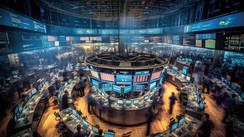The Evolving Landscape of the Stock Market
As an investor, you likely have a general idea of the standing of the Dow Jones Industrial Average. However, this may not offer a comprehensive picture of the stock market's actual performance, thereby potentially causing misunderstandings about your own investment trajectory.
In the investment world of 2023, we've seen a dichotomous stock market emerge. On one side of this divide, a small group of significant tech corporations are flourishing, pushing boundaries, and creating wealth. On the other side, the rest of the market is languishing, with many sectors struggling to stay afloat. This split has significant implications for index performance; the Dow has grown a meager 1.2% in 2023, while the broader S&P 500 has surged by over 9% (this does not factor in reinvested dividends). Data from the Bespoke Investment Group reveals that this is the largest divergence in performance between these two indices since the year 1945. If you've been overly focused on the Dow's lackluster performance, it could distort your perception of your portfolio's recovery journey from the losses of 2022.
The Lure of High-Risk Opportunities
The sterling performance of some market leaders could tempt you to engage in what could be seen as a financial 'Hail Mary'. This involves taking on substantial risks in an attempt to match the pace of these thriving market leaders. This year, expensive growth stocks, recognized for their elevated prices, have seen a significant increase of 21%. The ARK Innovation fund, steered by renowned stock-picker Cathie Wood and known for its predilection for high-value futuristic stocks, has experienced an impressive surge of 25%. Even more remarkably, MicroSectors FANG+, a security group encompassing some of the hottest tech giants, has seen a meteoric rise of 53%.
In stark contrast, low-cost value stocks have performed even worse than the Dow, taking a 2% hit. This lackluster performance is attributed to the Dow's unique design, which doesn't assign greater weightage to larger companies as is the practice with the S&P 500.
Impact of Major Stocks on the Dow
Take the case of UnitedHealth Group, for instance, which trades around $480. It has the most influence in the Dow, accounting for over 9% of the index's value. However, its impact on the S&P 500 is minuscule, slightly above 1%. The nearly 10% decrease in UnitedHealth's shares this year significantly contributes to the Dow's underperformance.
What about the impact of tech titan Apple on the Dow? With its share growth of 35% this year, one would expect it to lift the Dow's performance. However, due to its share price being considerably lower than UnitedHealth's, trading at roughly $175, it contributes only 3.4% to the Dow. Conversely, Apple carries a weight of 7.4% in the S&P 500. According to Howard Silverblatt, senior index analyst at S&P Dow Jones Indices, if Apple and Microsoft were proportioned in the Dow by market value rather than share price, they would constitute a staggering 24.8% and 22.6% of the index respectively.
Chasing Losses: A Risky Strategy
This nuanced market situation serves as a stark reminder: if your investment portfolio is heavily tilted towards the leading tech stocks of this year, you've likely reaped substantial financial benefits. If not, you may be facing disappointing returns. An undue fixation on your underperformance could lead you down the path of 'loss chasing'. This psychological trap leads investors to take bigger, more frequent, and impulsive risks in an attempt to recoup losses. This strategy doesn't always involve purchasing more of the underperforming stocks, but instead often translates into buying the stocks that promise the highest potential for growth, even if they carry substantial risks.
The Neuroscience Behind Losses
Scientific research in the field of neuroscience has unveiled that the decision to cease chasing losses can trigger brain areas associated with pain and disgust. The realization that your high-risk attempts are more likely to lead to further losses is a tough pill to swallow. This is why many investors find it hard to abandon this detrimental behavior, despite understanding that persisting in such decisions only deepens their financial setbacks.
Navigating the Waves of Loss
Different investors might have varied responses to losses. Some may double down on their investments, hoping for a swift recovery, while others may gravitate towards what seems like a safer choice. For example, long-term Treasury bonds have witnessed a nearly 10% rise this year and have consequently seen an influx of investments. However, such a move has its perils, particularly if the Federal Reserve does not initiate interest rate cuts soon.
Surviving the tumultuous waves of losses involves not just financial acumen, but also psychological fortitude. The way you perceive a loss depends heavily on your reference point. The severity of a loss can appear significantly different when viewed through different time frames. A broader perspective may reveal that you're not as far behind the market as you initially thought. Therefore, before embarking on a risky loss-chasing endeavor, it's crucial to ascertain whether what you're experiencing is indeed a loss or just a temporary setback.
Drawing Conclusions: Finding Balance in Market Turbulence
The ongoing developments and dichotomies in the 2023 stock market serve as stark reminders of the intricate dynamics of investing. It's crucial to note that being attuned to the performance of big market indices alone can give a skewed perception of your investment performance and market health. Understanding the dichotomy between thriving tech giants and underperforming sectors can help clarify your investment strategies.
With the lure of high-performing growth stocks, it's tempting to adopt a 'Hail Mary' approach, taking on increased risk to gain higher returns. However, this can lead to loss chasing - a risky strategy that has been linked to negative emotional responses and can further deepen financial setbacks.
Each investor responds differently to market losses, with some doubling down on their investments, hoping for swift recovery, while others lean towards seemingly safer options. However, your perception of loss is subjective and heavily dependent on your chosen reference point. Taking a broader, longer-term view can often paint a different picture, revealing that you may not be as far behind the market as you initially thought.
Ultimately, surviving in this divided market requires not just financial savvy but also emotional resilience. Taking a balanced approach, which includes making peace with losses, can prevent high-risk investment decisions and pave the way for long-term financial success. Remember, the world of investing is a marathon, not a sprint. It's essential to keep this in mind when considering your next move in the current market scenario.





